Single-Thermocouple Suspended Microfluidic Thermal Sensor with Improved Heat Retention for the Development of Multifunctional Biomedical Detection
Abstract
1. Introduction
2. Design and Evaluation of Thermal Sensor Devices
2.1. Design of Thermal Sensor Devices
2.2. Theoretical Derivation and Evaluation
3. Thermal Distribution Simulation and Fabrication of the Sensor Device
3.1. Model of the Device
3.2. Thermal Distribution of the Device
3.3. The Response Time Performance of the Device
3.4. Fabrication and Structure of the Device
4. Results and Discussion
4.1. Characterization of Thermal Distribution
4.2. Thermal Sensing Performance of the Device
4.3. Application Prospects of Multi-Component Detection
5. Conclusions
Author Contributions
Funding
Institutional Review Board Statement
Informed Consent Statement
Data Availability Statement
Conflicts of Interest
References
- Sen, M.A.; Kowalski, G.J.; Fiering, J.; Larson, D. A continuous flow microfluidic calorimeter: 3-D numerical modeling with aqueous reactants. Thermochim. Acta 2015, 603, 184–196. [Google Scholar] [CrossRef] [PubMed]
- Iervolino, E.; van Herwaarden, A.; Sarro, P. Calorimeter chip calibration for thermal characterization of liquid samples. Thermochim. Acta 2009, 492, 95–100. [Google Scholar] [CrossRef]
- Yang, H.; Tu, C.; Jia, Z.; Meng, Q.; Zhang, J.; Wang, J.; Zhao, Y.; Zhu, C.; Bao, F. Dynamic characterization of thermocouples under double-pulse laser-induced thermal excitation. Sensors 2023, 23, 2367. [Google Scholar] [CrossRef] [PubMed]
- Su, S.; Niu, T.; Vogt, T.; Eckert, S. In-Bulk Temperature Profile Mapping Using Fiber Bragg Grating in Fluids. Sensors 2023, 23, 8539. [Google Scholar] [CrossRef] [PubMed]
- Ranaweera, M.; Kim, J.-S. Cell integrated multi-junction thermocouple array for solid oxide fuel cell temperature sensing: N+ 1 architecture. J. Power Sources 2016, 315, 70–78. [Google Scholar] [CrossRef]
- Yang, Y.; Li, X.; Li, Z.; Li, M.; Chen, Y.; Tan, S.; Yu, H.; Xu, P.; Li, X. Integrated Microcantilever for Joint Thermal Analysis of Trace Hazardous Materials. Sensors 2025, 25, 3004. [Google Scholar] [CrossRef] [PubMed]
- Souza, E.; Pinheiro, P.; Coutinho, F.; Dias, J.; Pilar, R.; Pontes, M.J.; Leal-Junior, A. Smart Concrete Using Optical Sensors Based on Bragg Gratings Embedded in a Cementitious Mixture: Cure Monitoring and Beam Test. Sensors 2024, 24, 7998. [Google Scholar] [CrossRef] [PubMed]
- Wise, J. Rectal thermometer should be used for accurate temperature reading, analysis finds. BMJ 2015, 351, h6125. [Google Scholar] [CrossRef] [PubMed]
- Weed, H.G. Peripheral thermometers do not have clinically acceptable accuracy for measuring core body temperature. Ann. Intern. Med. 2016, 164, JC32. [Google Scholar] [CrossRef] [PubMed]
- Vernon, G. Inaccuracy of forehead thermometers. BMJ 2013, 346, f1747. [Google Scholar] [CrossRef] [PubMed]
- Feng, J.; Svatoš, V.; Liu, X.; Chang, H.; Neužil, P. High-performance microcalorimeters: Design, applications and future development. TrAC Trends Anal. Chem. 2018, 109, 43–49. [Google Scholar] [CrossRef]
- Fan, S.; Gao, Y. Numerical simulation on thermoelectric and mechanical performance of annular thermoelectric generator. Energy 2018, 150, 38–48. [Google Scholar] [CrossRef]
- de Souza, K.M.; Silva, R.N.; Silva, J.A.; Brites, C.D.; Francis, B.; Ferreira, R.A.; Carlos, L.D.; Longo, R.L. Novel and High-Sensitive Primary and Self-Referencing Thermometers Based on the Excitation Spectra of Lanthanide Ions. Adv. Opt. Mater. 2022, 10, 2200770. [Google Scholar] [CrossRef]
- Wu, C.; Cheng, J.; Zhang, Y.; Yao, P. A LAMP Detection System Based on a Microfluidic Chip for Pyricularia grisea. Sensors 2025, 25, 2511. [Google Scholar] [CrossRef] [PubMed]
- Chen, W.; Wang, P.; Li, B. Experimental Study on SPR Array Sensing Chip Integrated with Microvalves. Sensors 2024, 24, 2540. [Google Scholar] [CrossRef] [PubMed]
- Narberhaus, F.; Waldminghaus, T.; Chowdhury, S. RNA thermometers. FEMS Microbiol. Rev. 2006, 30, 3–16. [Google Scholar] [CrossRef] [PubMed]
- Liu, D.; Shi, P.; Ren, W.; Liu, Y.; Niu, G.; Liu, M.; Zhang, N.; Tian, B.; Jing, W.; Jiang, Z. A new kind of thermocouple made of p-type and n-type semi-conductive oxides with giant thermoelectric voltage for high temperature sensing. J. Mater. Chem. C 2018, 6, 3206–3211. [Google Scholar] [CrossRef]
- Kimberger, O.; Thell, R.; Schuh, M.; Koch, J.; Sessler, D.; Kurz, A. Accuracy and precision of a novel non-invasive core thermometer. Br. J. Anaesth. 2009, 103, 226–231. [Google Scholar] [CrossRef] [PubMed]
- Steier, A.; Muñiz, A.; Neale, D.; Lahann, J. Emerging trends in information-driven engineering of complex biological systems. Adv. Mater. 2019, 31, 1806898. [Google Scholar] [CrossRef] [PubMed]
- Spearing, S. Materials issues in microelectromechanical systems (MEMS). Acta Mater. 2000, 48, 179–196. [Google Scholar] [CrossRef]
- Saadon, S.; Sidek, O. A review of vibration-based MEMS piezoelectric energy harvesters. Energy Convers. Manag. 2011, 52, 500–504. [Google Scholar] [CrossRef]
- Morimoto, Y.; Kiyosawa, M.; Takeuchi, S. Three-dimensional printed microfluidic modules for design changeable coaxial microfluidic devices. Sens. Actuators B Chem. 2018, 274, 491–500. [Google Scholar] [CrossRef]
- Lu, S.; Ma, D.; Mi, X. A High-Throughput Circular Tumor Cell Sorting Chip with Trapezoidal Cross Section. Sensors 2024, 24, 3552. [Google Scholar] [CrossRef] [PubMed]
- Mehmood, Z.; Haneef, I.; Udrea, F. Material selection for micro-electro-mechanical-systems (MEMS) using Ashby’s approach. Mater. Des. 2018, 157, 412–430. [Google Scholar] [CrossRef]
- Ding, X.; Lin, Q.; Wang, M.; Liu, S.; Zhang, W.; Chen, N.; Wang, Y. Design and simulation of high-performance D-type dual-mode PCF-SPR refractive index sensor coated with Au-TiO2 layer. Sensors 2024, 24, 6118. [Google Scholar] [CrossRef] [PubMed]
- Wu, Y.; Lei, M.; Xia, X. Research Progress of MEMS Gas Sensors: A Comprehensive Review of Sensing Materials. Sensors 2024, 24, 8125. [Google Scholar] [CrossRef] [PubMed]
- Liao, M.; Sang, L.; Teraji, T.; Koizumi, S.; Koide, Y. Ultrahigh performance on-chip single crystal diamond NEMS/MEMS with electrically tailored self-sensing enhancing actuation. Adv. Mater. Technol. 2019, 4, 1800325. [Google Scholar] [CrossRef]
- Kjeang, E.; Djilali, N.; Sinton, D. Microfluidic fuel cells: A review. J. Power Sources 2009, 186, 353–369. [Google Scholar] [CrossRef]
- Wang, Z.; Kimura, M.; Ono, T. Manufacturing and characterization of simple cantilever thermal biosensor with Si-Metal thermocouple structure for enzymatic reaction detection. Thermochim. Acta 2018, 668, 110–115. [Google Scholar] [CrossRef]
- Sayin, S.; Zhou, Y.; Wang, S.; Acosta Rodriguez, A.; Zaghloul, M. Development of liquid-phase plasmonic sensor platforms for prospective biomedical applications. Sensors 2023, 24, 186. [Google Scholar] [CrossRef] [PubMed]
- Chang, W.-Y.; Hsihe, Y.-S. Multilayer microheater based on glass substrate using MEMS technology. Microelectron. Eng. 2016, 149, 25–30. [Google Scholar] [CrossRef]
- Belmonte, J.C.; Puigcorbe, J.; Arbiol, J.; Vila, A.; Morante, J.; Sabate, N.; Gracia, I.; Cane, C. High-temperature low-power performing micromachined suspended micro-hotplate for gas sensing applications. Sens. Actuators B Chem. 2006, 114, 826–835. [Google Scholar] [CrossRef]
- Bató, L.; Fürjes, P. Vertical Microfluidic Trapping System for Capturing and Simultaneous Electrochemical Detection of Cells. Sensors 2024, 24, 6638. [Google Scholar] [CrossRef] [PubMed]
- Gao, X.; Chen, Y.; Xu, P.; Zheng, D.; Li, X. γ-Fe2O3-Based MEMS Gas Sensor for Propane Detection. Electronics 2025, 14, 1050. [Google Scholar] [CrossRef]
- Gan, Y.; Yang, M.; Sun, F.; Yang, L. A quantitative model and solution of reaction heat for microfluidic chips based on Kriging and NSGA-II. Thermochim. Acta 2020, 694, 178803. [Google Scholar] [CrossRef]
- Yuan, Z.; Yang, F.; Meng, F.; Zuo, K.; Li, J. Research of low-power MEMS-based micro hotplates gas sensor: A Review. IEEE Sens. J. 2021, 21, 18368–18380. [Google Scholar] [CrossRef]
- Winterstein, T.; Staab, M.; Nakic, C.; Feige, H.-J.; Vogel, J.; Schlaak, H.F. SU-8 electrothermal actuators: Optimization of fabrication and excitation for long-term use. Micromachines 2014, 5, 1310–1322. [Google Scholar] [CrossRef]
- Song, J.; Seo, J.; Han, J.; Lee, J.; Lee, B.J. Ultrahigh emissivity of grating-patterned PDMS film from 8 to 13 μm wavelength regime. Appl. Phys. Lett. 2020, 117, 094101. [Google Scholar] [CrossRef]
- Yule, L.; Harris, N.; Hill, M.; Zaghari, B.; Grundy, J. Temperature hotspot detection on printed circuit boards (pcbs) using ultrasonic guided waves—A machine learning approach. Sensors 2024, 24, 1081. [Google Scholar] [CrossRef] [PubMed]

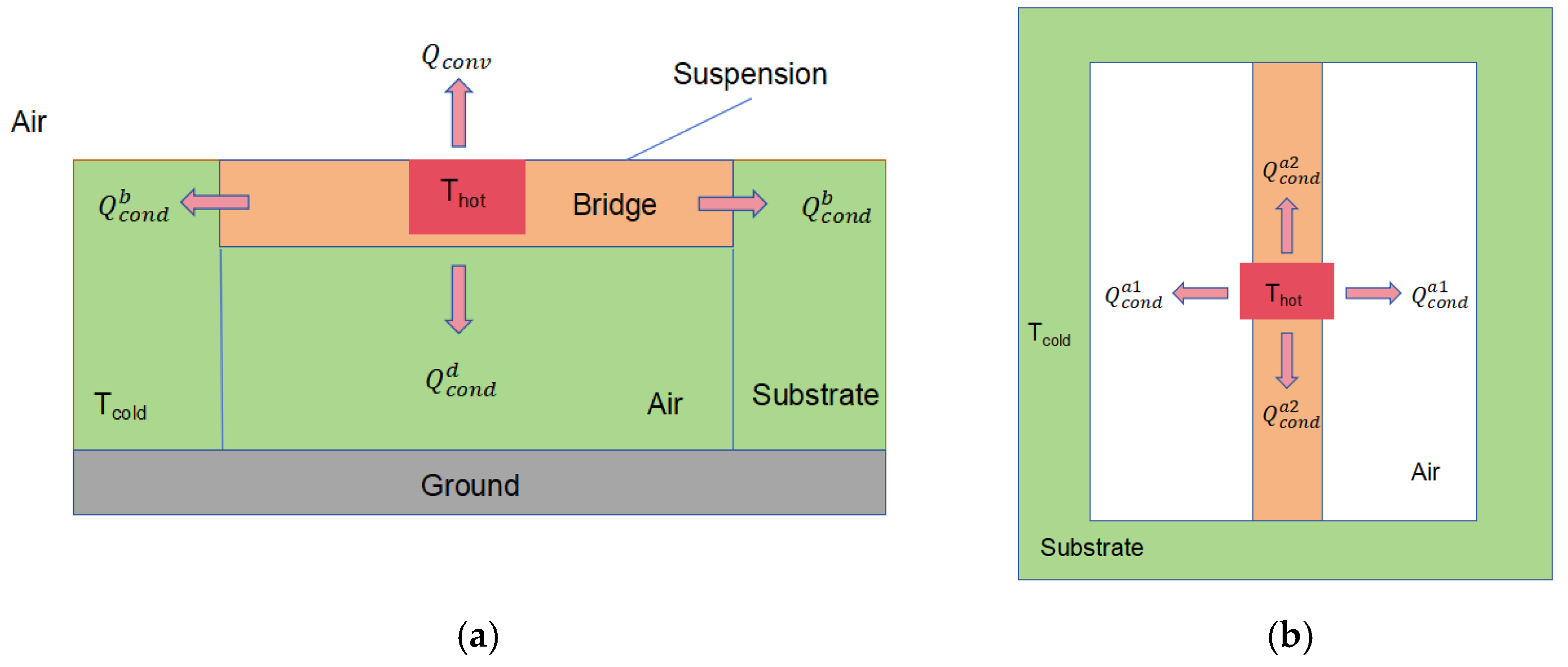
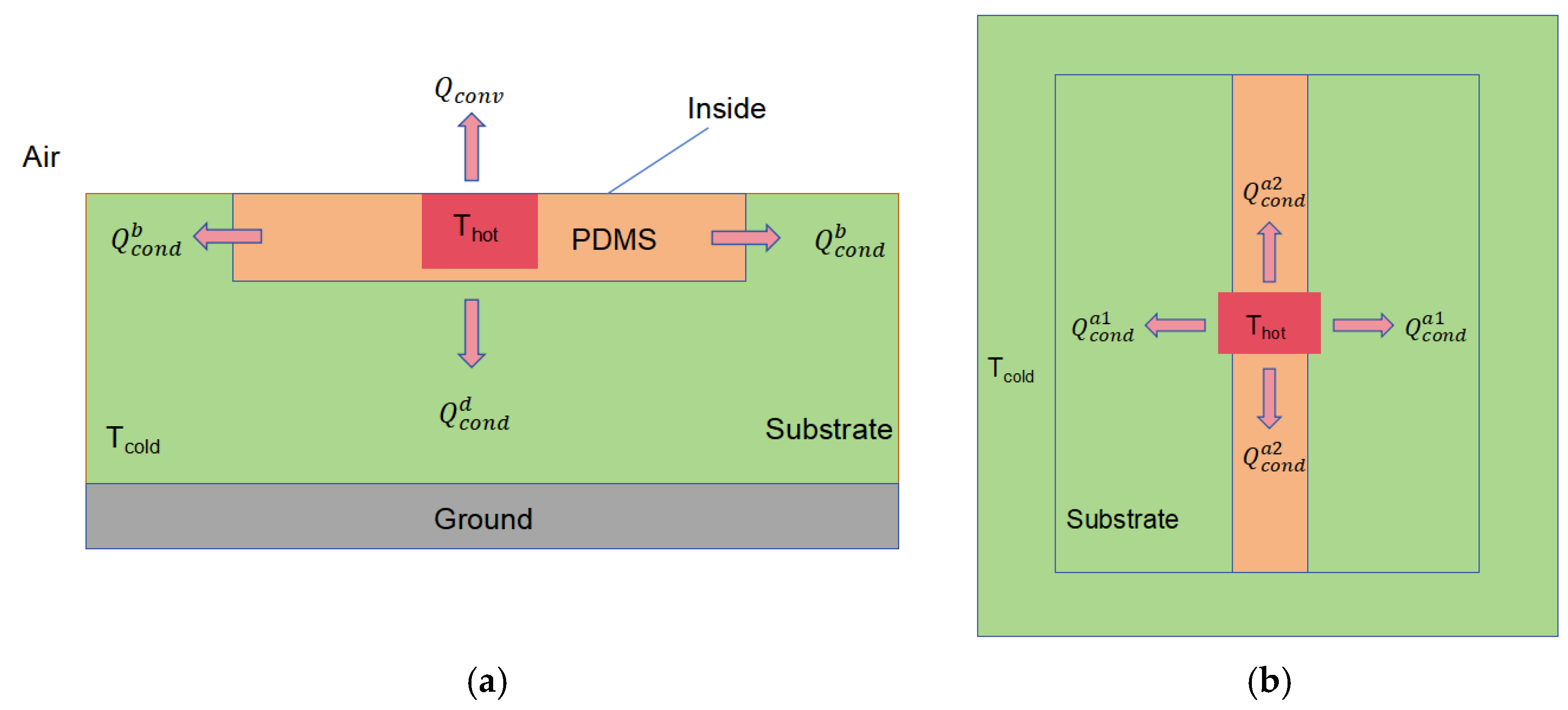
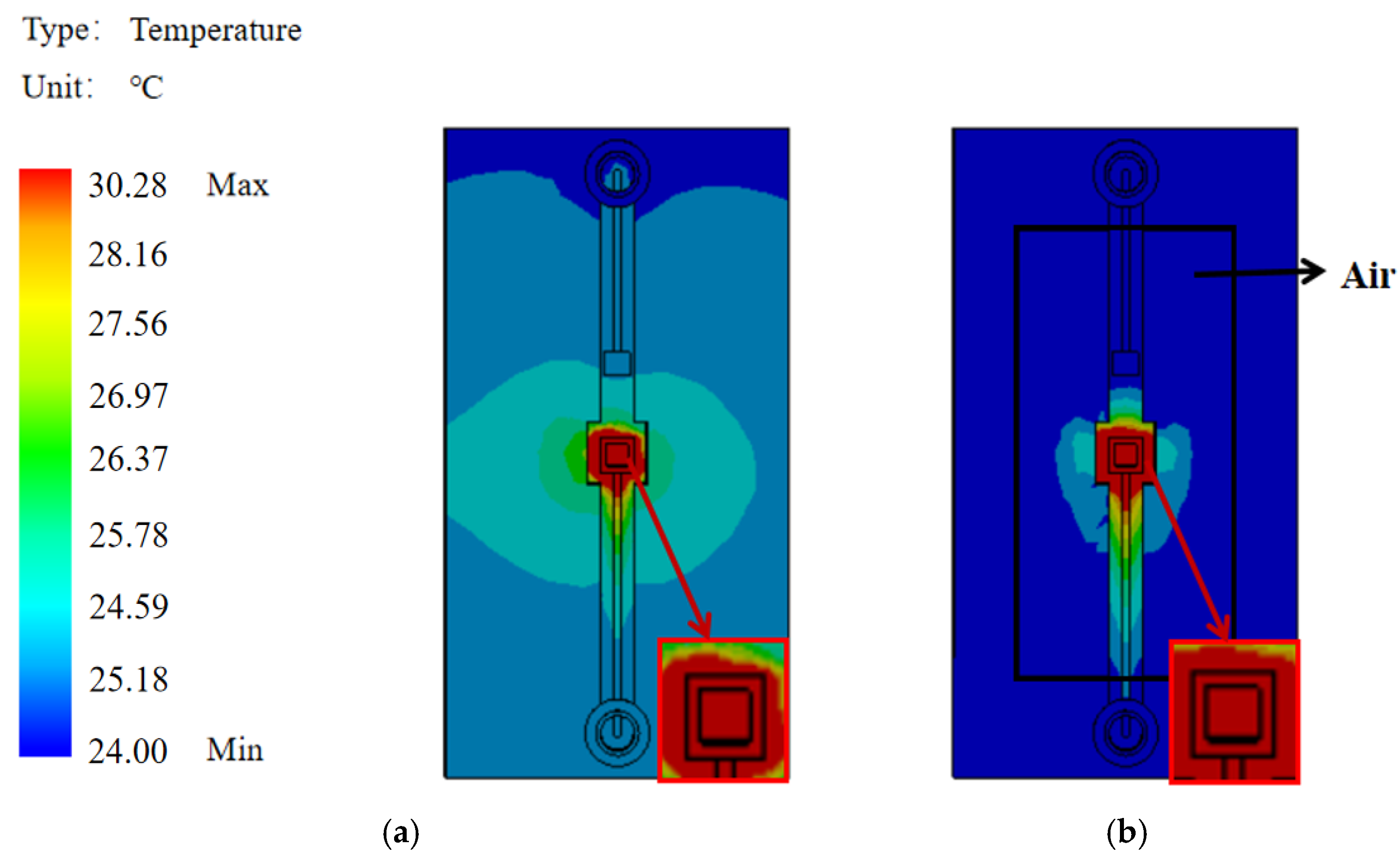


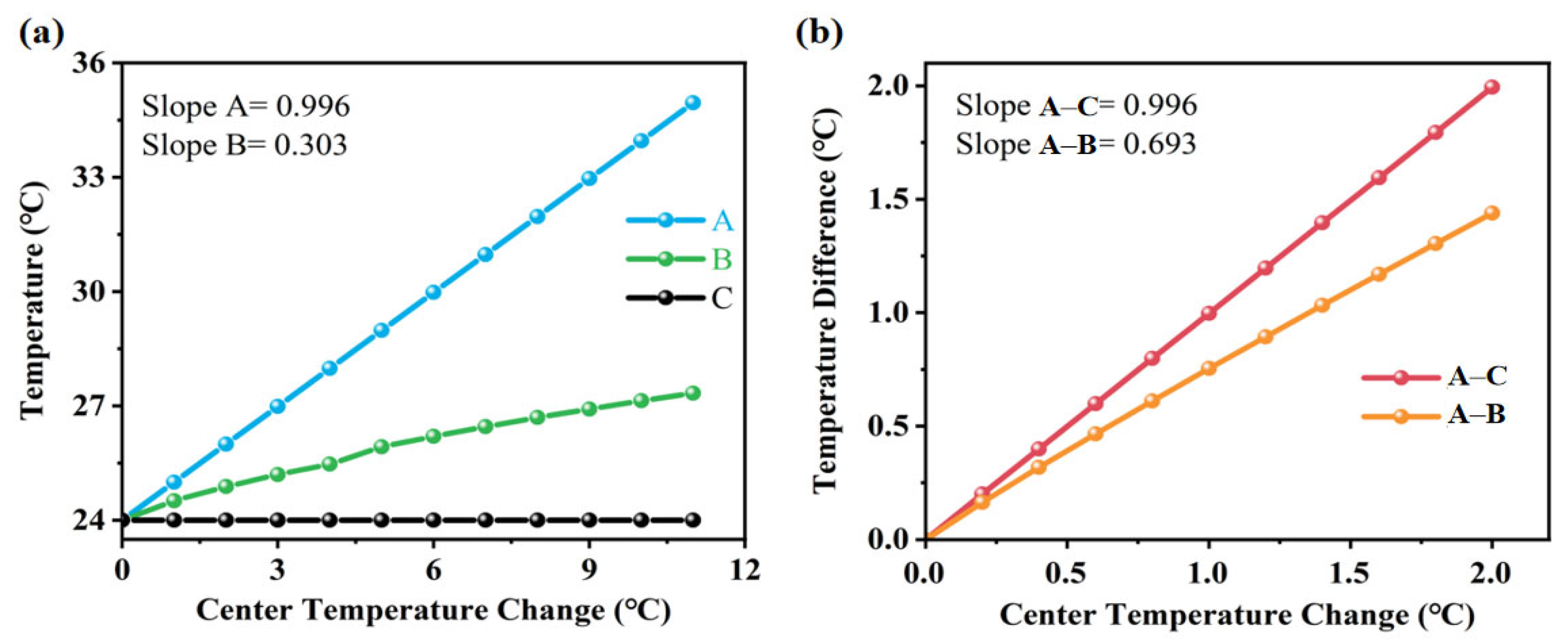

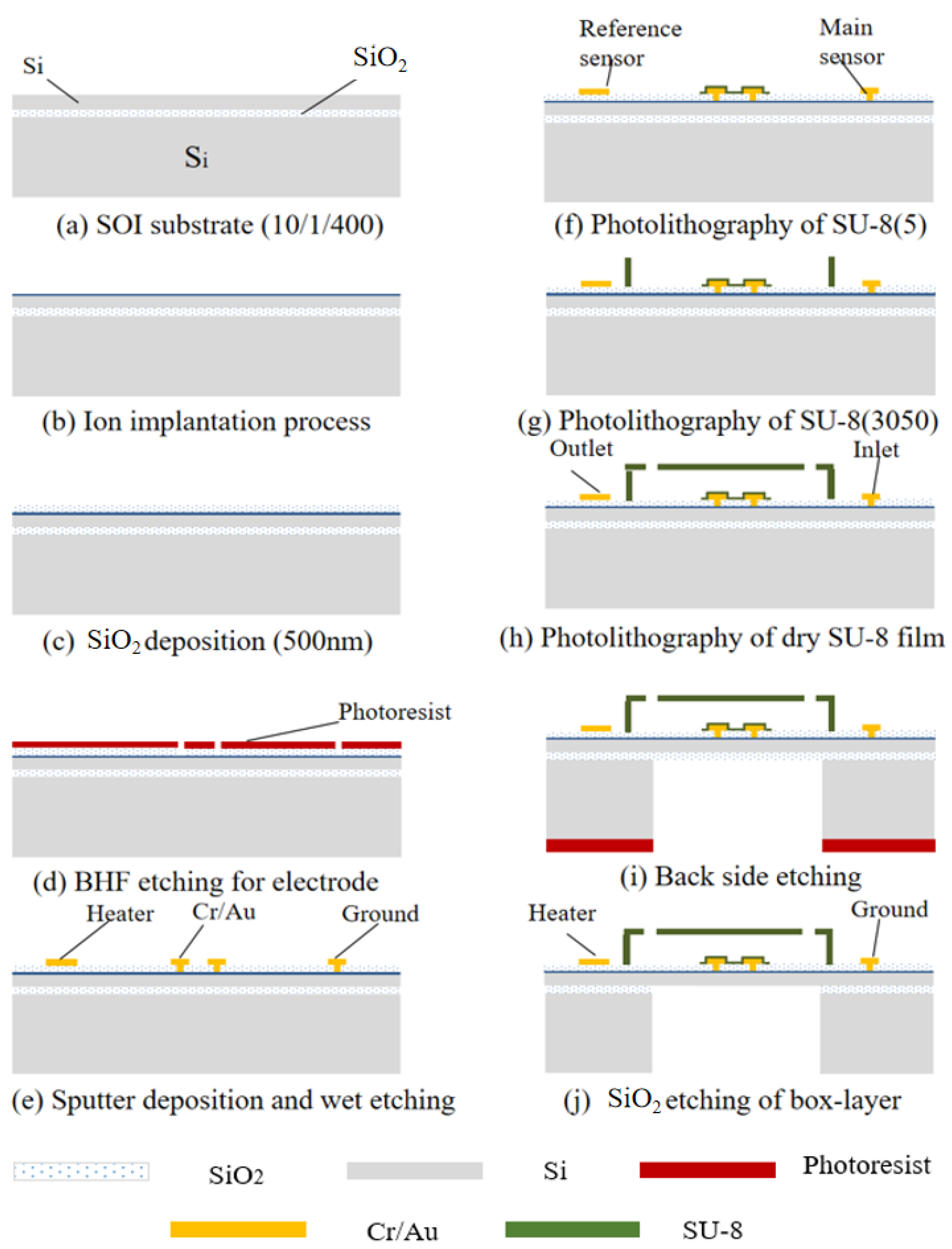


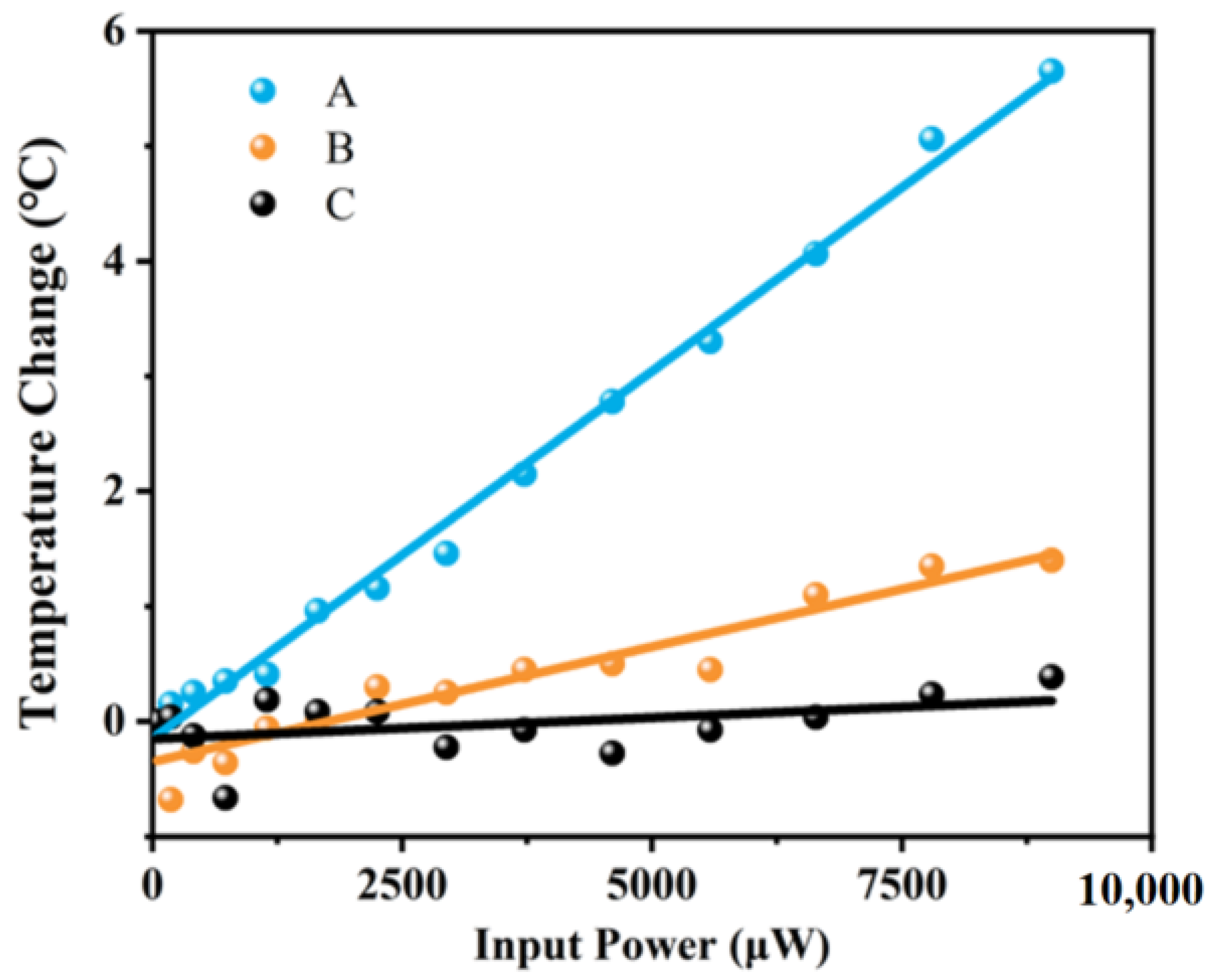
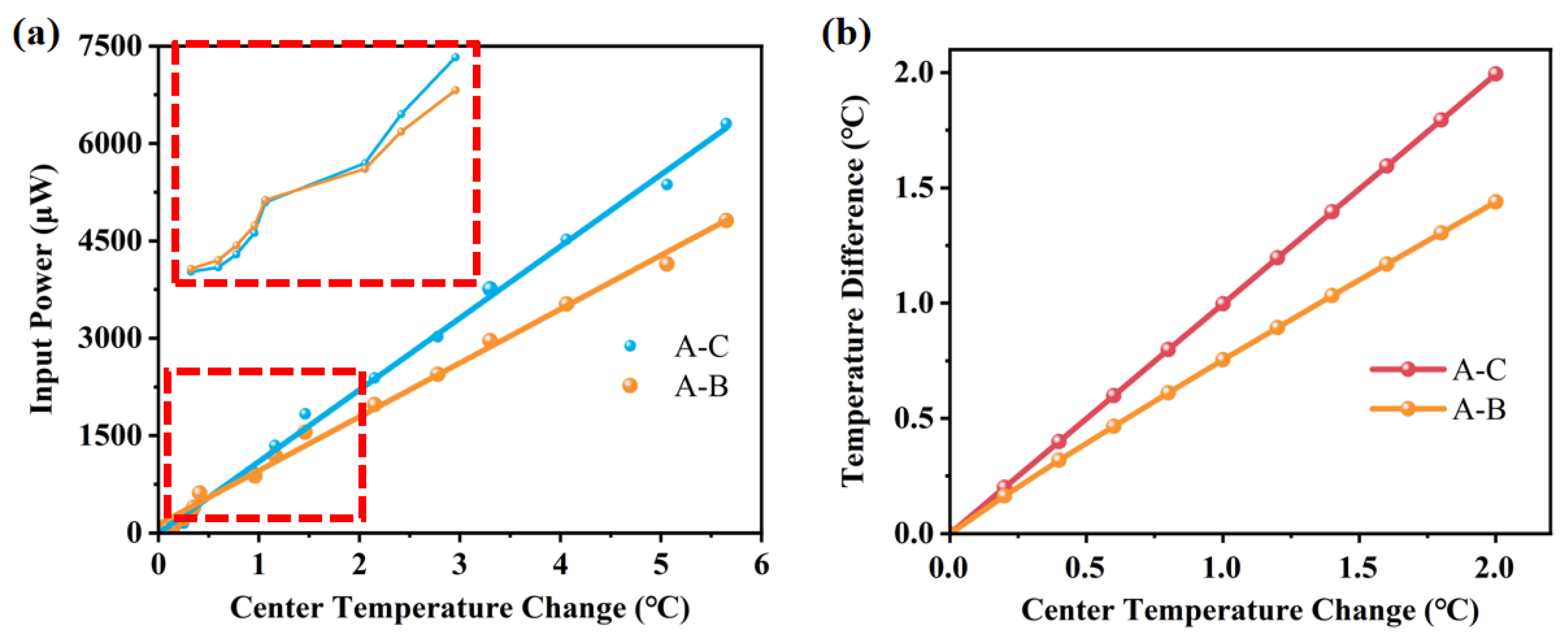


Disclaimer/Publisher’s Note: The statements, opinions and data contained in all publications are solely those of the individual author(s) and contributor(s) and not of MDPI and/or the editor(s). MDPI and/or the editor(s) disclaim responsibility for any injury to people or property resulting from any ideas, methods, instructions or products referred to in the content. |
© 2025 by the authors. Licensee MDPI, Basel, Switzerland. This article is an open access article distributed under the terms and conditions of the Creative Commons Attribution (CC BY) license (https://creativecommons.org/licenses/by/4.0/).
Share and Cite
Qin, L.; Wang, X.; Wu, C.; Ju, Y.; Zhang, H.; Cheng, X.; Xia, Y.; Xia, C.; Huang, Y.; Wang, Z. Single-Thermocouple Suspended Microfluidic Thermal Sensor with Improved Heat Retention for the Development of Multifunctional Biomedical Detection. Sensors 2025, 25, 4532. https://doi.org/10.3390/s25154532
Qin L, Wang X, Wu C, Ju Y, Zhang H, Cheng X, Xia Y, Xia C, Huang Y, Wang Z. Single-Thermocouple Suspended Microfluidic Thermal Sensor with Improved Heat Retention for the Development of Multifunctional Biomedical Detection. Sensors. 2025; 25(15):4532. https://doi.org/10.3390/s25154532
Chicago/Turabian StyleQin, Lin, Xiasheng Wang, Chenxi Wu, Yuan Ju, Hao Zhang, Xin Cheng, Yuanlin Xia, Cao Xia, Yubo Huang, and Zhuqing Wang. 2025. "Single-Thermocouple Suspended Microfluidic Thermal Sensor with Improved Heat Retention for the Development of Multifunctional Biomedical Detection" Sensors 25, no. 15: 4532. https://doi.org/10.3390/s25154532
APA StyleQin, L., Wang, X., Wu, C., Ju, Y., Zhang, H., Cheng, X., Xia, Y., Xia, C., Huang, Y., & Wang, Z. (2025). Single-Thermocouple Suspended Microfluidic Thermal Sensor with Improved Heat Retention for the Development of Multifunctional Biomedical Detection. Sensors, 25(15), 4532. https://doi.org/10.3390/s25154532






